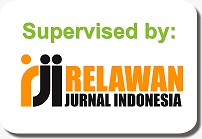Regulation analysis of negative emotions of male students
Abstract
When entering adolescence, individuals experience several psychological and physiological changes. One of the psychological changes that occur during adolescence is socio-emotional change, where adolescents have relatively high emotional tension, such as several incidents of disputes and fights between students, which indicates a lack of ability to regulate and control the negative emotions that exist in them. This study aims to describe the ability of male students at MTs Siulak Gedang to regulate negative emotions. Quantitative research with a descriptive quantitative approach was chosen for this study, and questionnaires were used to obtain information from the respondents. The results obtained are generally seen from the acquisition of the average indicator score: (1) Able to manage positive and negative emotions, where this indicator obtains an average value of 2.95, which means it is included in the high category; (2) Able to realize and control emotions automatically, this indicator also obtains an average value that is also included in the high category, which is equal to 2.96, and in the last indicator (3) Being able to deal with stress from problems encountered also obtains high results, where in this indicator students get the average value of 3.04.
Downloads
References
Andriyani, J. (2019). Strategi coping stres dalam mengatasi problema psikologis. At-Taujih: Bimbingan Dan Konseling Islam, 2(2), 37-55.
Anggita. K. (2019). Kasus Pengeroyokan Audrey, Bukti Remaja Belum Mampu Mengatur Emosi. https://www.medcom.id/rona/keluarga/yNLvrqyk-kasus-pengeroyokan-audrey-bukti-remaja-belum-mampu-mengatur-emosi.
Azmi, A. U., Mustika, R. I., & Supriatna, E. (2021). Strategi Self-Management Untuk Mengembangkan Stabilitas Emosi Siswa. FOKUS (Kajian Bimbingan & Konseling dalam Pendidikan), 4(3), 235-240.
Azmi, N. (2015). Potensi emosi remaja dan pengembangannya. Sosial Horizon: Jurnal Pendidikan Sosial, 2(1), 36-46.
Brown, B. B., & Prinstein, M. J. (Eds.). (2011). Encyclopedia of Adolescence. Academic Press.
Faiz, A., Yandri, H., Kadafi, A., Mulyani, R. R., Nofrita, N., & Juliawati, D. (2019). Pendekatan Tazkiyatun An-Nafs untuk membantu mengurangi emosi negatif klien. Counsellia: Jurnal Bimbingan Dan Konseling, 9(1), 65-78.
Gross, J. J., & Muñoz, R. F. (1995). Emotion regulation and mental health. Clinical psychology: Science and practice, 2(2), 151.
Gross, J. J., Richards, J. M., & John, O. P. (2006). Emotion Regulation in Everyday Life. In D. K. Snyder, J. Simpson, & J. N. Hughes (Eds.), Emotion regulation in couples and families: Pathways to dysfunction and health (pp. 13–35). American Psychological Association.
Hasmarlin. H. (2019). Regulasi Emosi Pada Remaja Laki-laki dan Perempuan. Marwah: Jurnal Perempuan, Agama dan Jender. 18(1): 90.
Jamil, W. (2020). Psikologi Agama & Kesehatan Mental. Samudra Biru.
Nadhiroh, Y. F. (2015). Pengendalian emosi: Kajian Religio-psikologis tentang Psikologi Manusia. SAINTIFIKA ISLAMICA: Jurnal Kajian Keislaman, 2(01), 53-62.
Oktasari, D., Yandri, H., & Juliawati, D. (2020). Analisis Pelanggaran Tata Tertib Sekolah Oleh Siswa Dan Peran Guru Bimbingan Dan Konseling Di Sekolah. Jurnal Mahasiswa BK An-Nur: Berbeda, Bermakna, Mulia, 6(4), 16-21.
Ratnasari, S., & Suleeman, J. (2017). Perbedaan regulasi emosi perempuan dan laki-laki di perguruan tinggi. Jurnal Psikologi Sosial, 15(1), 35-46.
Rusmaladewi, D. R. I., Kamala, I., & Anggraini, H. (2020). Regulasi Emosi pada Mahasiswa Selama Proses Pembelajaran Daring di Program Studi PG-PAUD FKIP UPR. Jurnal Pendidikan Dan Psikologi Pintar Harati, 16, 33-46.
Santrock, J. W. (2004). Life-span development. Belmont, CA: McGraw-Hill Higher Education.
Subana. M. S. (2001). Dasar-Dasar Penelitian Ilmiah. Pustaka Setia.
Sugiyono. (2013). Metode Penelitian Kuantitatif, Kualitatif dan R&D. Alfabeta.
Ulya, M. (2021). Pengelolaan dan Pengendalian Emosi Negatif Perspektif Al-Qur’an. El-'Umdah, 4(2), 159-184.
Wahyono. E. (2020). Miris kelompok Remaja di Jakarta Barat Aksi Tawuran Biar Viral. https://news.detik.com/berita/d-5156121/miris-kelompok-remaja-di-jakarta-barat-aksi-tawuran-biar-viral.
Yuliani, R. (2013). Emosi negatif siswa kelas XI SMAN 1 Sungai Limau. Jurnal Ilmiah Konseling, 2(1), 151-155.
Yuzarion, Y., Agustiana, A. K., Alfaiz, A., Yandri, H., Musdizal, M., & Aulia, R. (2020). Learning achievement was reviewed from self-regulated learning, future orientation, and parental support. COUNS-EDU: The International Journal of Counseling and Education, 5(2), 71-80.
Zonya, O. L. (2019). Perbedaan Regulasi Emosi Siswa Laki-laki dan Perempuan (Doctoral dissertation, Universitas Negeri Padang).
Zulkifli. (2012), Psikologi Perkembangan. Remaja Rosdakarya
Copyright (c) 2023 Harmalis Harmalis, Farid Imam Kholidin, Inggrid Portuna Ningsih

This work is licensed under a Creative Commons Attribution 4.0 International License.








